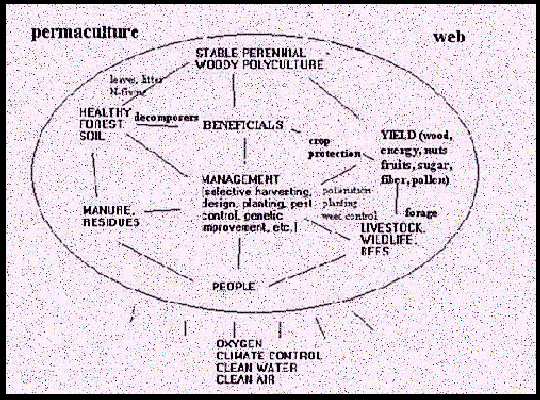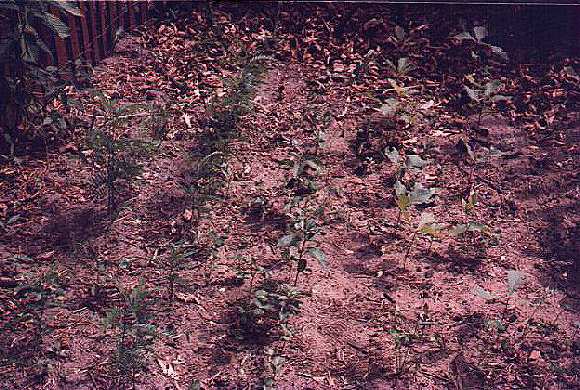This is hopefully the beginning of a continuing effort to communicate some basic knowledge about a new approach to sustainable living on our planet with its diminishing resources and increasing population. I tend to think that nearly everyone has this dilemma and seemingly insurmountable problem in the back of their mind to maul over and become depressed about. It may certainly contribute to the overwhelming problems of self-destructive and sociopathic behaviors rampant in our society and world.
Permaculture is a way of life, a "think globally, act locally" philosophy that optimistically states that we all have resources we need to live productive and fullfilling lives if we look around us at what nature and the creator has provided. These include inexhaustible and nonpolluting solar energy and millions of species of plants which have untold and unknown uses many of which are known in traditional cultures and by modern science, and the ability of plants and animals species to function in an ecosystem synergistically such that the whole is greater than the sum of its parts. This concept is pretty much ignored today by science, which seeks to isolate in order to study-something which isn't realistic in the real world. The relatively new science of ecology is the most notable exception. Finally, Permaculture places our species homo sapiens back into the ecosystem from whence we came and to where we belong.
The word "permaculture", a contraction of permanent agriculture was originally coined by Bill Mollison of Australia who developed its core principles. Its highly recommended if not essential to read any of his books. Since he and others first described permaculture in the late 1970's the movement has spread world wide with literally thousands of individuals and groups practicing it. There is a strong presence on the internet of permaculture groups world wide.
In ecology and its practical application, permaculture, the interconnectedness of components can be graphically approximated.

Which ecosystems in nature are most productive? One answer you hear most often is rain forests. Very little time and money has been used for the development of the rain forest model to become food producing. You can bet the benefits to the planet and especially to the inhabitants of those areas would be enormous. A lesser known fact is that temperate wetlands can be equally productive, in terms of photsynthesis and CO2 fixation(remember that decadent rock band: CO2 and the greenhouse effect). Two components of ecosystems that are areas of increased productivity is edge where interface occurs such as forest edge and water edge. The other area of interest is using the 3rd and 4th dimension, so to speak, when we speak of the multistory aspect of forests both above and below the ground that can utilize all energy, nutrient and water imputs most effectively, and the ability of plants to succeed other plants in succession where certain species produce optimal conditions for more specialized species.
In most places in Michigan, any area if let alone will develop into a stable climax forest, such as a beech-maple-yellow birch, or oak-hickory depending on moisture availability and location. Nature can do the job of reforestation well but doesn't use varieties and species that we can use and it takes too long-probably several lifetimes(it would be interesting to conjecture about a planet where the intelligent lifeform lived longer than trees-they wouldn't be wasting their time messing with weed species like corn, wheat, tomatoes, etc, when they can use plants who don't have to grow a new supporting structure every year.)
So permaculture needs to start with nurseries. Anyone can grow trees from seed. Usually you just stick the acorn or whatever in the ground and voila.

This is one of my first attempts at tree propagation back in 1983. Many of these honeylocusts(an animal forage producer), american persimmons(generally hardy here) and bur oaks(produces quantities of large acorns) are presently growing on my farm. I can't say that they are producing bumper crops(basically nothing yet) but the potential is there.